Back to the Coast
We really enjoyed staying a week in Cordova back in June, and we were looking forward to going back to resupply for our last section. When we were picking up our resupply package at the post office, the lady giving it to us, realized that we planned to walk to where we were staying with the very heavy box, and asked another woman who just had picked her packages to give us a ride. Funnily enough, we recognized her. We had met Lauren 10 days on the McCarthy road, when she stopped and asked if we were OK. She was curious to hear about our last section down the Copper River, and was more than happy to give us a ride. When we got to where we stayed, we ended up talking for an hour about our trip, gear, Alaska adventures and life. She invited us for dinner the next night, and when she realized that Steve, the pilot who is helping us in our trip, we invited him too. We had a wonderful evening in her beautiful and cozy cabin.
The next day, we got a ride to the end of the road, where we had taken out two days ago. It was drizzly and overcast, which was an improvement over the incessant rain the day before. It’s rarely sunny over here, and we had had two sunny days while rafting the Copper. To head towards Icy Bay, we put in again on the Copper River and ran it to the ocean. We thought the current would slow down close to the delta, but the river was pretty swift for a long time. We made 16 miles in a few hours.
The Copper River Delta is more than 50 miles wide, and it’s mostly composed of shallow river channels and sandbars. We saw a bear running around while floating, and lots of seals. Salomé was studying the insects swimming on the river, that were struggling to survive. She figured out that catching the insects with her paddle and letting them dry their winds on her boat, they would start again flying. It was fun. We took out before the delta became even wider, fearing we would run out of dry land to camp on. Over dinner, we mesmerized at the far away islands, that changed shape over and over again due to mirages on the river.
We finally got to the shallows the next day. We had to drag our boats over 4 inch shallow water for a few hundred yards, but it wasn’t as bad as we expected, as we were able to find a deep channel that went all the way to ocean. We knew we were safe when we started setting fishing boats in the same channel as us. We talked to Ben, from the Tommyknocker, who was waiting for an opener in 4 days and decided to hang out in the delta instead of going back to Cordova. We could understand why, the foggy conditions reflected the light on the glassy water, it was beautiful. We also noticed the salmon swimming by our boats and leaving distinct wake patterns on the water surface. They even bumped out boats!
We finally landed on one of the barrier islands, and walked there tidal flats until we hit the sand berm, and finally saw the ocean. We are back after a few months! The sea was calm, as the area around the delta is already protected from worst of the pacific storm swells. We then turn due east, and headed down the coast. Icy Bay is just 120 miles away. The sand was hard-packed. We were going for it!
We quickly were surprised by the coast. Crossing from the barrier island to the mainland, just over a mile away, became tricky. A submerged sandbar was creating 3 foot breaking waves. Our intuition of staying upstream brought us straight to the waves. We had to head towards open waters to go around them, but not without getting some water in our boats. Landing was quite fun though, as we both surfed incoming waves all the way to the coast.
We stayed at a forest service cabin tucked in into the forest. It was a beautiful location, with a lush forest around it, and a view to a beautiful grassy marsh just before beach. The cabin had an axe and a saw so we cut firewood for the night. We were pretty happy to be in a cabin as it rained hard all night. We were surprised, the weather was supposed to be good last time we looked at the forecast in Cordova. In the morning, we waited for a break in the weather and then started packing to get going. But the hard rain started again, and the wind was now blowing hard on the beach. We got a weather forecast through the satellite communicator, and it looked like it was going to stay the same the whole day. It wasn’t hard to decide to wait out the weather, the cabin was too good. Later we learned that it rained 5 inches that day.
The next morning we went around Cape Martin and headed towards the old town of Katalla, that boomed shortly when it was considered to be the end station for the Copper River Railroad, which ended up going towards Cordova. We saw the remains of an old pier, a ship wreck on the river, and cool artifacts like a safe, railway ties and more. There was a small fishing lodge in Katalla, where we were warmly welcomed by Scott, his staff and guests. They even invited us for lunch and gave us some extra food, which was great as we had consumed some of our extra food the day we sat in the cabin.
The next challenge was Controller Bay, a 15 mile wide bay that is enclosed by the 5 mile long Kanak Island and massive tidal flats. We started crossing the first channel, that drains the Bering River, and camped on Kanak Island. We saw three coyotes just before setting out the tent, and listened to them howling while cooking dinner. The next day, we took it easy as we had to wait for low tide to cross the tidal flats. The weather was opening up and the water was glassy. The tidal flats were endless, and yet we had to cross them before the incoming tide would make them disappear. We rushed the 4 miles until we got the last small channel flowing out of Controller Bay, which we easily crossed on our boats. We could then finally relax and enjoy the shining sun and the calm seas. We were at the tip of a miles long sand spit enclosing Controller Bay, and it was beautiful.
As we walked towards Cape Suckling, we tried to recall if the few trip reports we had found online mentioned whether it was easy or hard to get around. We feared that we needed low tide, and the following day had a fairly high low tide in the middle of the day. We wanted to avoid a sketchy scrambling on steep rock faces, and as we water was still surprisingly calm, we started wondering whether we could paddle around it. We charged ahead and walked 10 miles in a bit more than 3 hours on a benign beach. We finally got the the rock cliffs at 730 pm, and we quickly dressed up to paddle around the cliffs. It would be a short paddle, less than a mile, but in the open ocean, so we didn’t take our chances and put our dry suits on. It was a good idea, as when we launched we poorly timed the incoming surf and a wave crushed over Salomé’s boat as she paddled frenetically. Once past the breakers, we enjoyed the views, the sun was setting on the west and hitting the cliffs of volcanic origin. We landed just after the cliffs and set up camp in the beach. But before that we enjoyed the last minutes of the sunset. We couldn’t complain about the weather! We were really enjoying the coast this time, what a difference compared to our time in May.
Things got a bit harder the following day. As we were packing camp, we saw that a bear had walked within 20 yards of the tent. Low clouds set in the morning and developed into thick fog. We felt that it were in a long tunnel, with the beach on one side and a sand dunes in the other. We kept walking, hoping that we would get to the end. We started seeing blocks of ice stranded on the beach. We knew they were probably coming from the Seal River, a major outlet of the massive Bering Glacier. The icebergs became more frequent as the day went on. At the mouth of the Seal River, the beach was completely littered with ice, and many of the biggest icebergs were still tumbling in the surf. The fog was so thick we couldn’t see the other end of the river, just massive chunks of ice swiftly floating into the ocean. We marveled at the surreal scene at the beach, with fog obscuring the wild shapes of ice waiting on the beach for a bigger tide to take them back into the open ocean. We also wondered how we would cross the river without visibility. After all, we’re had been warned by multiple people of how dangerous the river was.
As the fog lifted a little bit, we decided to continue upriver to see if it would clear before dark. Instead, within a few minutes the fog set in further, and we decided to scrap our plans to cross the river that night. As Salomé loved so much the scene at the river mouth, we walked back to it, hoping the conditions would be better in the morning and we could enjoy the beach in better lighting. That night we made a nice camp fire and waited for the fog to go away. But it didn’t, so the next day we retraced our steps along the river bank in dense fog, and walked upstream far enough to not be swept away into the open ocean. We inflated our boats and paddled between the icebergs towards the other shore which we couldn’t see due to the fog. Once on the other side, we quickly made it back to the beach, and continued heading east.
Our goal for the day was the Alaska Expedition Lodge by the Tsiu River from where we are writing this past. It is a fishing and hunting lodge we had contacted in the winter and that agreed to keep a package for us, that Steve the pilot in Cordova flew in a few days before. It’s set between grassy sand dunes, huge stretches of marsh and the river, and is famous for its record-sized moose and abundant brown bears and silver salmon. Jason and Leslie, the owners also allowed us to stay for the night and dinner.
Unfortunately, the weather forecast for the following two days looked terrible, with 50 mph winds, which made the prospects of walking and camping on the beach miserable at best. We decided to stay and wait out the storm at the lodge, and we will continue tomorrow towards Icy Bay. We’re now 60 miles away, about 4 days of walking and half a day of paddling, but there is little dry weather in the forecast. But we still hope it to make it there before the next big weather system.


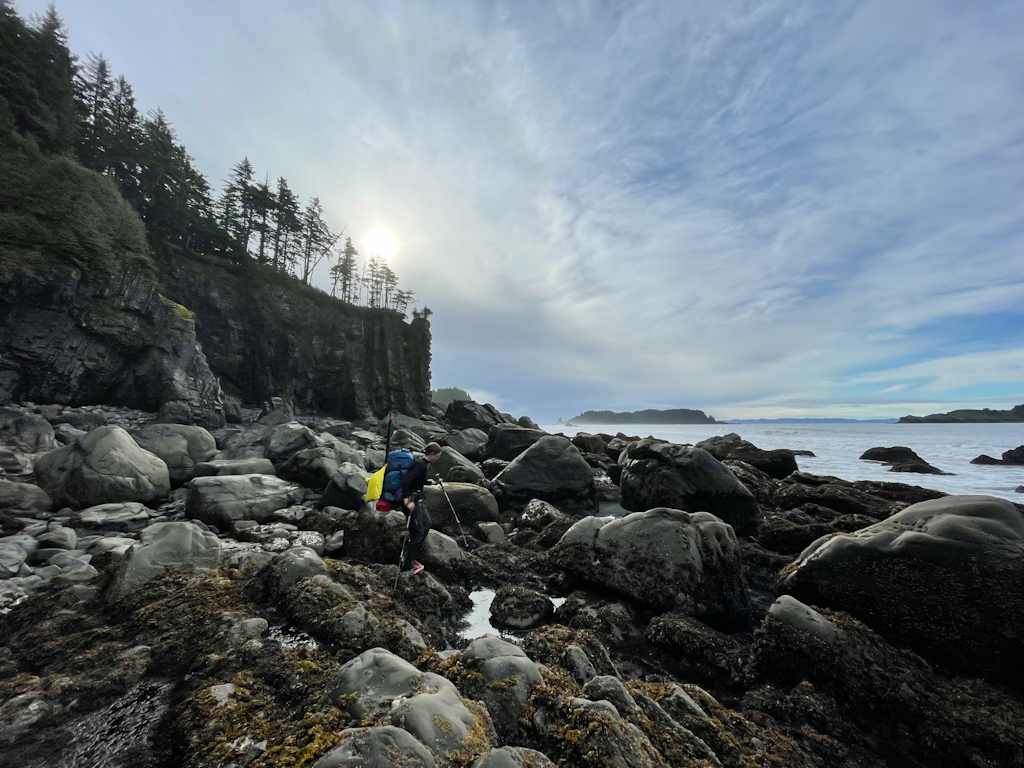


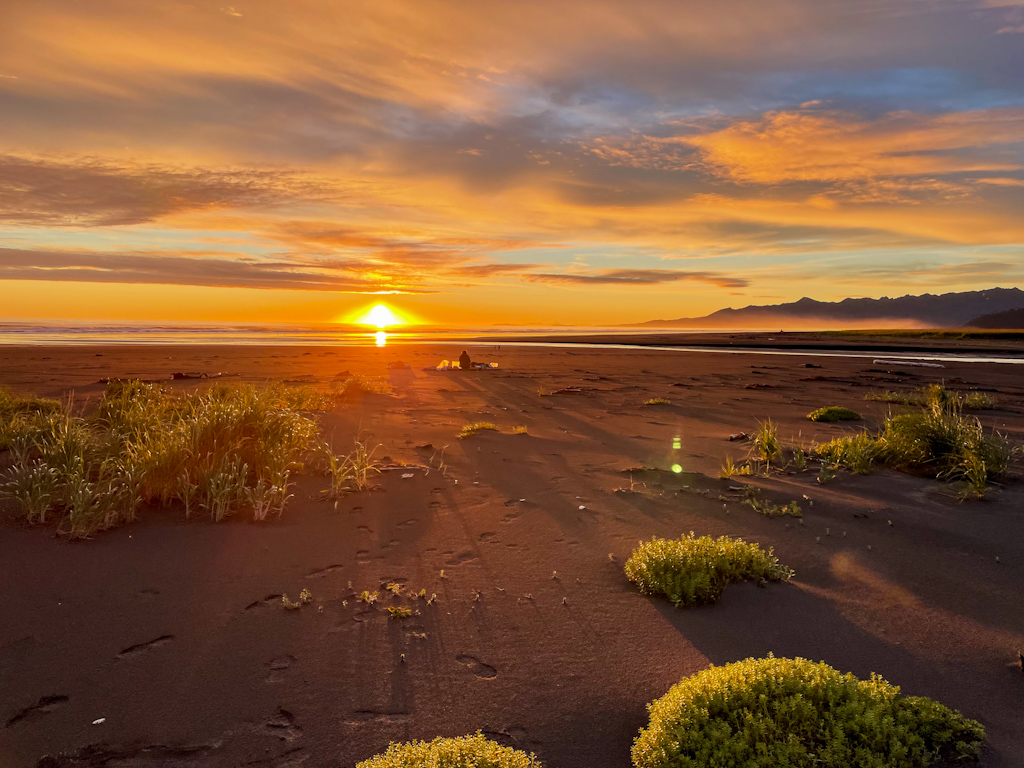
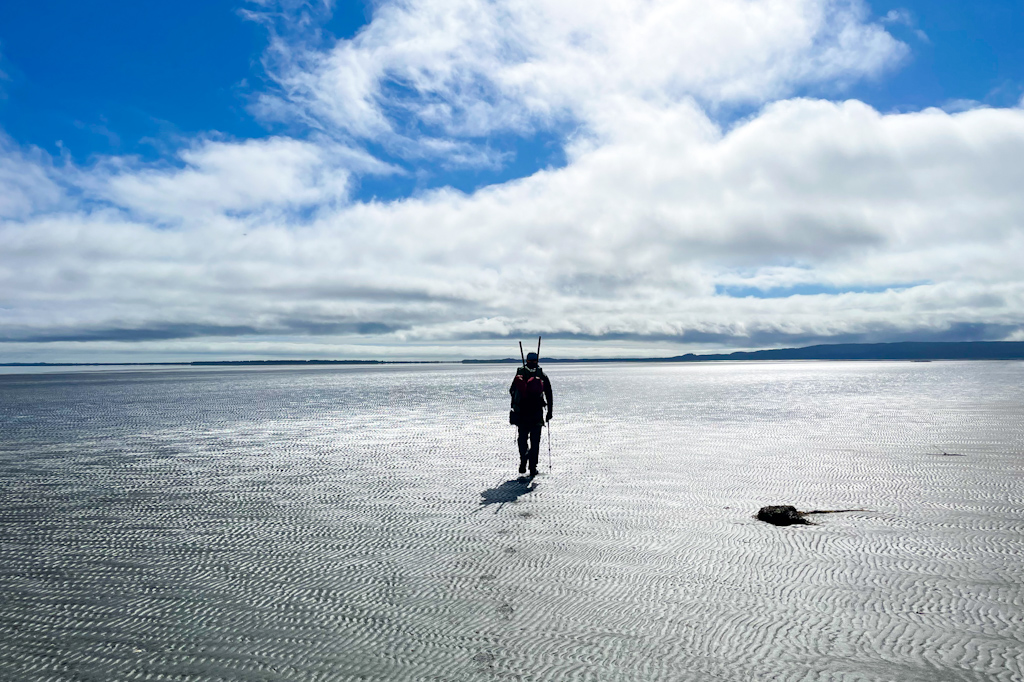
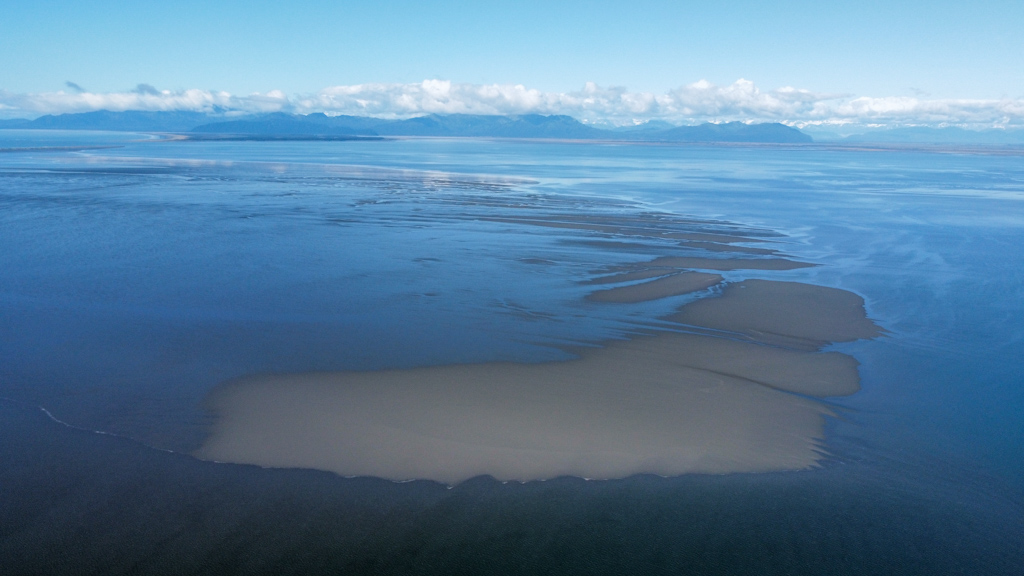
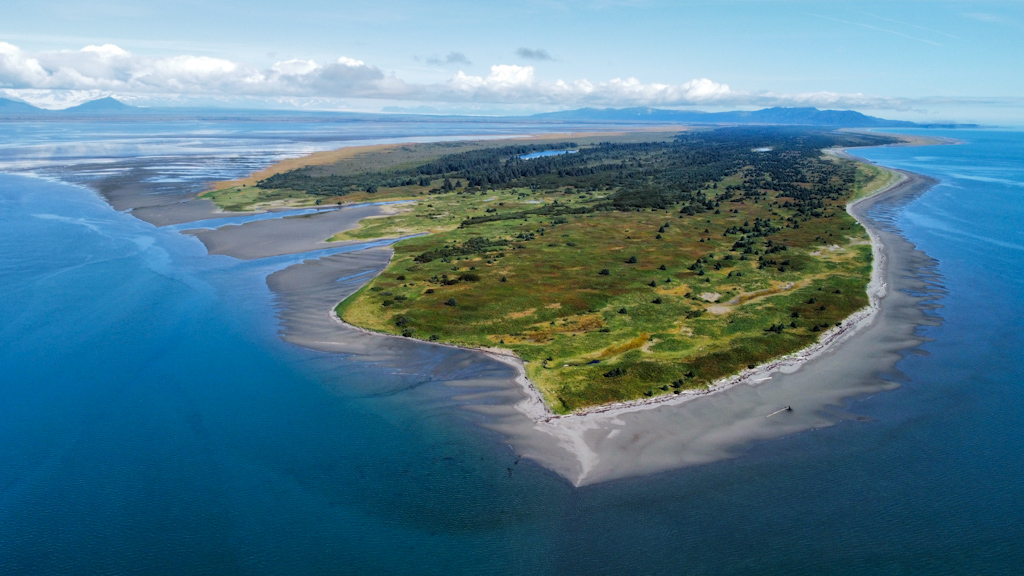



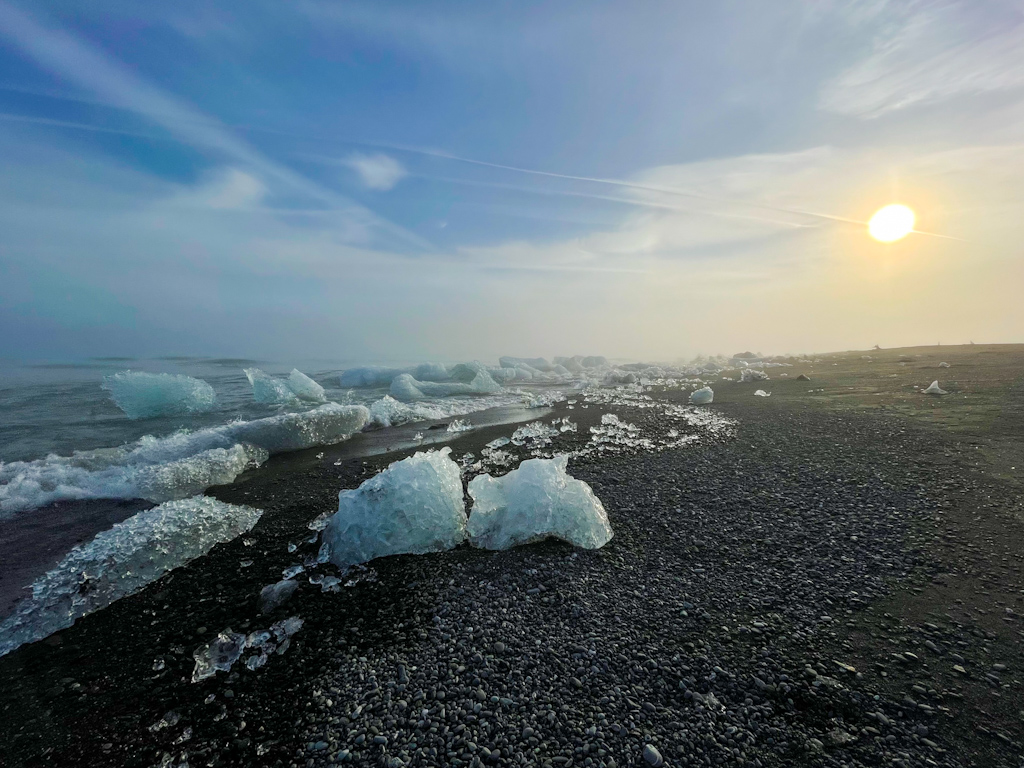



Comments
Keunhong Park
The scenery is surreally beautiful!
Jeff Erickson
I love your pictures and the description of your hike. Sounds like the rain was abundant! I got my mom and her friends to the lighthouse for two nights and spent a day at leConte glacier. I’m heading to Seattle for the third time Susan’s sister is still with us. Call when you get home. Jeff